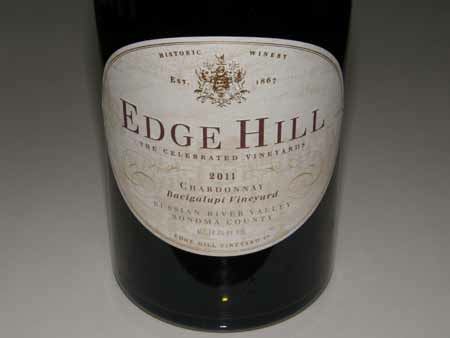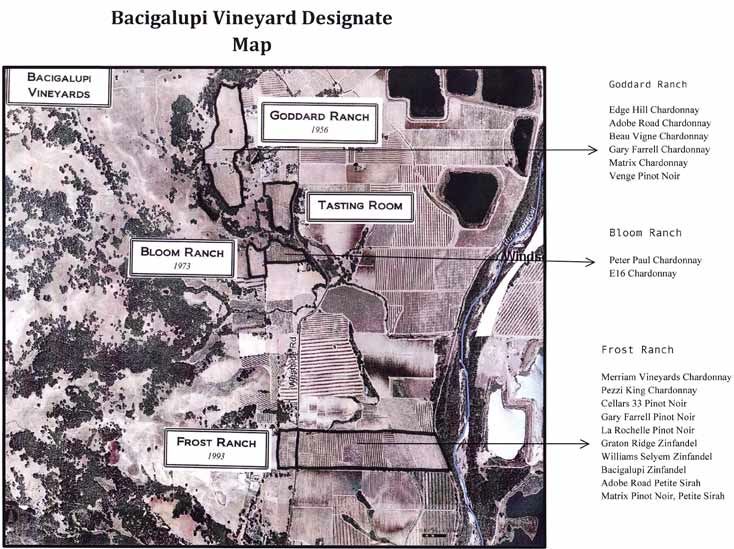Bacigalupi Family 50th Anniversary Celebration & 3rd Anniversary Vineyard Designate Tasting
Recently, the Bacigalupi family celebrated the 50th Anniversary of the planting of Pinot Noir and
Chardonnay at Goddard Ranch in Healdsburg, a milestone in California winegrowing history that
played an important role in the outcome of The 1976 Judgment of Paris Tasting. They also held a
Bacigalupi Vineyard Designate Tasting adjacent their tasting room where fifteen wineries poured
Chardonnay, Pinot Noir, Zinfandel and Petite Sirah from Bacigalupi vineyards. I thoroughly enjoyed
this opportunity to taste wines from various producers and mix with the delightful Bacigalupi family.
Fifty years ago, prunes took precedent over wine grapes in the Russian River Valley and grapevines
were relegated to the poorest ground. The Italian fore bearers who had settled the region had planted
field blends of Zinfandel, Petite Sirah and Carignane, but there were also extensive plantings of white
wine grapes including French Colombard, Golden Chaslis and Mission. These white varieties are
nearly extinct today in the region. Locals had little interest in or knowledge of Pinot Noir and
Chardonnay, the two grape varieties that now dominate the Russian River Valley landscape.
John Bacigalupi, the son of Charles and Helen Bacigalupi, who grew up on the family ranch, tells the
humorous story of the time his father called Foppiano Winery in Healdsburg to tell him that his crop of
Pinot Noir and Chardonnay was ripe and ready to pick. The winery told him they could not be
bothered, as they were too busy processing prunes.
When Charles and Helen Bacigalupi put the early plantings of Pinot Noir and Chardonnay in the
ground on Westside Road in 1964, most locals thought it folly to plant grapes that nobody wanted.
Charles Bacigalupi, who was born in Santa Rosa, became a successful dentist in Healdsburg, and his
spouse, Helen, was trained as a pharmacist. They had always wanted a ranch in the country, and in
1956 they acquired the 121-acre Goddard Ranch on a bench on Westside Road in Healdsburg. The
ranch had some plantings of Zinfandel, Golden Chaslis, Mission and Muscat, as well as prunes and
cherries.
The Bacigalupis had no farming experience but their scientific backgrounds served them well and
both had a green thumb. The white grapes on the property brought in little income, so they decided to
pull out those vines and replant. Upon the advice of Paul Heck, a patient of Charles’ who was a
partner in Korbel Champagne Cellars, and Bob Sisson, the University of California at Davis farm
advisor for Sonoma County, they planted Pinot Noir and Chardonnay instead of the popular Zinfandel.
The Bacigalupis had scarce knowledge of Pinot Noir and Chardonnay and only vaguely realized that
the two varieties grew in France.
Karl Wente supplied the Bacigalupis with Wente selection budwood from his Livermore plantings. 6
acres of Wente selection Chardonnay and 6 acres of what was thought to be Pommard clone Pinot
Noir were planted on St. George rootstock in 1964 and field budded in 1965.
In 1973, Mike Grgich of Chateau Montelena came to the Bacigalupi’s house and asked to buy some
Chardonnay. He made 1,800 cases of the 1973 Chateau Montelena Chardonnay using 20 tons of
grapes from Henry Dick in Alexander Valley, 14 tons from the Bacigalupis, and the remaining 5 tons
from Napa Valley growers John Hanna and Lee Paschich. The original weight tag from 1973 is
displayed in the Bacigalupi’s tasting room.
Grgich’s 1973 Chateau Montelena Chardonnay won The 1976 Judgment of Paris, a blind tasting
organized by British wine merchant Steven Spurrier, where the top French wines were squared off
against California wines. The shocking victory by two California wines put California wine on the
world wine map and changed the global wine market dramatically.
According to Grgich, nine of the best judges in France were chosen, but they couldn’t obtain media
coverage because California wines commanded little respect at the time. George Tabor, a journalist
based in Paris, came over to the tasting because he had nothing better to do that day. When the
judging ended, the Chateau Montelena Chardonnay received 132 points, more than any other French
or California Chardonnay in the competition. When the results were revealed, some judges tried to
correct their scores, but Tabor was said to have prevented that.
In the afternoon, the judging panel tasted the Cabernet Sauvignons, and a 1973 Stag’s Leap Napa
Valley Cabernet Sauvignon came in first place. It received 127 points, so the Chateau Montelena
Chardonnay was the overall champion of The 1976 Judgment of Paris. Tabor would later publicize the
results and wrote a book about this seminal event, Judgment of Paris. A 2008 popular movie about
the event was titled ‘Bottle Shock.’
The 1973 Chateau Montelena Chardonnay that Grgich crafted is currently included in a Smithsonian
exhibition “101 Objects That Made America,” along side Abraham Lincoln’s hat, Alexander Graham
Bell’s telephone, and Neil Armstrong’s space suit.
The 4-acre Paris Tasting Block of Chardonnay on the Bacigalupi Ranch is still thriving and the grapes
are sold exclusively to Rudd Winery in Oakville where they are bottled under the Edge Hill label.
Established in 1867, Edge Hill was the first significant gravity-fed winery built in Napa Valley, and by
1880, it was one of the four wineries responsible for over half of Napa Valley’s wine production. In
1999, this legacy inspired Edge Hill’s new steward, Leslie Rudd, to begin the historic restoration of the
estate, and return Edge Hill to the prominence it had in the 19th century. Wines bottled under the
Edge Hill label pay homage to California’s historic vineyards and the rich history of California
viticulture. In my opinion, the Edge Hill Chardonnay is unquestionably one of the top Chardonnays
produced in California, or even in the world.

Although the results of The 1976 Judgment of Paris eventually were widely publicized, the vintners in
Napa Valley downplayed the fact that most of the Chardonnay grapes in the winning Chateau
Montelena wine came from Sonoma County. The label on the 1973 bottle underlies the attempt to
promote Napa Valley, state the source as “Napa and Alexander Valley,” without reference to Sonoma
County.
Through the years, the Bacigalupi family added other vineyard sites and how has three Russian River
Valley estate vineyards: Goddard Ranch, Bloom Ranch and Frost Ranch. Until 2002, the Bacigalupis
sold all their grapes to numerous Napa Valley and Sonoma County wineries. Today, Bacigalupi estate
grapes are part of many winery bottlings, and the Bacigalupi Vineyard is often designated. The aerial
photograph below shows the location of the three vineyards and lists the wineries that source grapes
from each vineyard site.

Beginning in 2002, the Bacigalupi family bottled their own wines using estate grapes under the John
Tyler label (an amalgam of John Bacigalupi and winemaker Tyler Heck’s first names). A tasting room
was built on the Goddard Ranch property and opened in June 2011. With the launch of the John
Tyler Wines label and the opening of the John Tyler Wines tasting room, John and Pam’s fraternal
daughters, Katey and Nicole, became the face of the winery, sharing in the management of the
winery’s business, direct sales, marketing, and staffing the tasting room.
In 2013, the name of the winery began transitioning from John Tyler Wines to Bacigalupi Wines to
honor the legacy of winegrowing of the Bacigalupi family. The first releases bearing the Bacigalupi
label were from the 2011 vintage and were vinified by the new consulting winemaker, Ashley
Hertzberg. The 2012 Bacigalupi Chardonnay, Pinot Noir and Zinfandel are superb.
Visit the Bacigalupi Wines website at www.bacigalupivineyards.com for more information and to
acquire the wines. Better yet, stop in at the informal and welcoming tasting room in Healdsburg
where you can view photos depicting the history of Bacigalupi Ranch and The 1976 Judgment of
Paris.